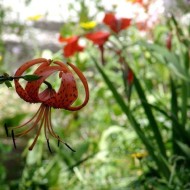Growing and using a tiger lily in garden design: planting options
Content
Common varieties and hybrids of tiger lilies
The lanceolate beauty originated from the wild forest lily native to Japan and China. It happened in the 19th century. Since then, not many varieties have been bred by breeders. Consider a description of the most popular of them:
- Slendens. This variety retains the orange color of the flowers. The plant itself is low (up to 1 m), the buds are large, up to 20 pieces can be located on the stem.
- Citronella. The buds of this lily are lemon-yellow, large (up to 12 cm in diameter), bloom for about 25 days. The plant is tall - 1–1.3 m.
- Flora Pleno. Terry variety with brick-colored flowers. The buds are large and lush, each with up to 30 petals.
- Pink Tiger. The buds of this lily are small and drooping, of a delicate pinkish hue.
- Knight Flyer. The brightest tiger variety. Its flowers reach a diameter of 16 cm, the color of the petals is claret-red with rare black blotches.

The popularity of the tiger lily is so great that a princess is named after her - a character from a book about the adventures of Peter Pan. “As beautiful as a lily, and unbridled as a tiger” - this is how the Scottish writer James Barry described his heroine.
Video "Planting and breeding lilies"
In this video, an expert will tell you how to properly plant and propagate lilies in the garden.
Features of planting and caring for tiger lilies
Growing lilies is not a hassle if you immediately find a good place and create favorable conditions.
Temperature and lighting requirements
Lilies of this species prefer a temperate climate. The optimum temperature for their active growth and flowering is + 19 ... + 26 ° C. When planting lilies, choose slightly shaded areas where there is sufficient sun in the morning. This is an important point, since lilies only open in good light. The root zone, on the contrary, is recommended to be shaded. This can be done with undersized and ornamental plants.
Soil and nutrient requirements
Lilies bloom best on light, fertile soil with neutral or slightly high acidity. They cannot stand water stagnation, therefore, when planting, you need to take care of high-quality drainage. The area where the lilies will be planted must be dug to the depth of a shovel, compost (1 bucket / m²), as well as mineral fertilizers - superphosphate (100 g) and potassium salt (50 g).
Planting and transplanting
For planting, babies are usually used, which are separated from the bulbs of adult plants. Before that, they are dipped for half an hour in a solution of potassium permanganate (5 g / 10 l of water).

The planting process is simple:
- small holes 10-15 cm deep are dug;
- a little sand is poured at the bottom of each, which will provide drainage;
- the bulbs are buried in the holes, covered with earth, the area is watered abundantly, and if planting is carried out in the fall, then covered with a layer of mulch.
The care of the bed is standard: watering, gentle loosening and weeding. Sprouted bulbs are transplanted to a permanent place, where they bloom after 1–2 years. Annual flowering is repeated every 4–5 years. Then the bulbs are depleted, but babies ripen on them, which are used for reproduction.
Tiger lilies are deadly to cats. All parts of this plant contain substances that are toxic to furry pets, which, if eaten, cause kidney failure.
Other breeding methods
In addition to daughter bulbs, lilies can be propagated in several other ways:
- Kidney bulbs. From the second year of life, small bulbs begin to form in the leaf axils. At the end of summer, they are harvested, sown in a substrate, and after rooting, they are transplanted into the soil. By the way, this is how lilies reproduce by self-seeding.
- Scales. When transplanting, scales are separated from the bulbs, planted in wet sand and in greenhouse conditions, after a few months, sprouts appear from them. In this way, more than 100 new plants can be obtained from one bulb.
- Seeds. This is a laborious process and an unreliable method, as the seed germination rate is 70%, but it is also sometimes used.
Lily bulbs have medicinal properties. They are used for the manufacture of pain relievers, tonic, hemostatic drugs and folk remedies.
Watering rates and soil care
Lilies do not need abundant watering. If they grow in a shaded part of the garden or are in a composition with ground cover plants, then they do not need to be watered. When located in a sunny area, moderate watering at the root is needed during the flowering period. It is better to produce them in the morning, so that excess moisture evaporates during the day.
After flowering, watering is gradually reduced. To maintain the required moisture, the soil is mulched or pallets with wet moss are used. It is also required to regularly loosen the soil and remove weeds, which can be carriers of fungi and pests.
Fertilizers and feeding
Regular feeding of lilies is also not required. Only during the period of active flowering, it is recommended to feed them with complex fertilizers 1 time in 3 weeks, but this is not necessary. If the flowers are planted in fertile soil and bloom well, then mineral fertilizers can be dispensed with or replaced with compost. The latter is scattered on the surface in spring, and is also introduced during transplantation.

Shelter for the winter
Lilies have excellent winter hardiness, and in snowy winters they do not need shelter - just a layer of snow is enough. But since snow is not always and not in all regions, it is better to hide wintering bulbs under a layer of organic matter.
Disease and pest control
Growing in a garden with other plants, lilies can be affected by fusarium, rust, gray rot. In addition, this species is itself a carrier of the mosaic virus, which manifests itself in spots on the leaves. To prevent these diseases from destroying the plants, they are sprayed from time to time with "Baktofit" or "Fundazol".
Typical pests of lilies are aphids, leaf beetles, scoops, lily flies, thrips. If insects have appeared on a flower, there is nothing left to do but use insects: "Aktara", "Iskra", "Confidor".
Flower in landscape design
Tiger lilies are often used in landscape design. Due to their height, they look gorgeous against the background of a flower arrangement or in the center of a large flower bed. In this case, you need to take into account the height, texture and shades of other colors that make up the composition.
So, tiger lilies go well with ground cover plants: stonecrop, periwinkle, saxifrage. Bright large flowers look advantageous against the background of ferns and stunted conifers. Terry varieties will make a great composition with phlox, asters. A yellow or brick lily will be favorably set off by a delphinium. The main thing is that the complementary plants are below the lilies themselves.
- Lilies have excellent winter hardiness.
- Lilies do not need abundant watering
- Tiger lilies are often used in landscaping.
- Tiger lilies blend well with other plants
- Tiger lilies are deadly for cats
- Tiger lilies are the most luxurious representatives of the garden flora
Florist reviews
“I have been breeding lilies for a long time, but tiger lilies are my favorite. I have several varieties that bloom at different times, so the garden is always fragrant. "
“As an experienced florist, I can say that these are the most hardy lilies. Even if you don't pay attention to them, they still bloom all summer ”.
Tiger lilies are the most luxurious and unpretentious representatives of the garden flora. They are suitable both for a home flower garden and for a design composition. In addition, even a novice gardener can grow this beauty.






